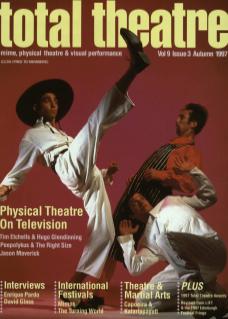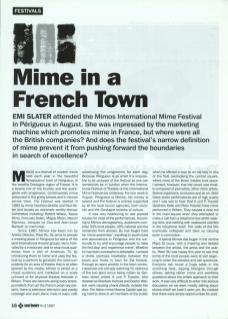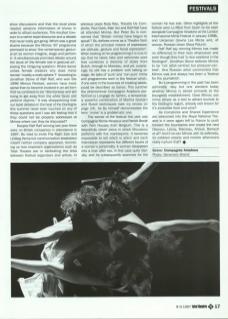Mimos is a festival of modern mime held each year in the beautiful Renaissance town of Périgueux, in the wealthy Dordogne region of France. It is a bizarre mix of the touristy and the avant-garde with progressive, contemporary mime presented in the pretty streets and in venues across town. The Festival was started in 1983 by mime teachers Ginette and Paul Tellier and boasts an extremely worthy Honour Committee including: Robert Wilson, Kazuo Ohno, Ferrussio Soleri, Maguy Marin, Marcel Marceau, Jacques Lecoq and Jean-Louis Barrault (in memorial).
Since 1987 Mimos has been run by Artistic Director Peter Bu. Bu aims to provide a meeting place in Périgueux for some of the best international theatre groups. He is motivated by a missionary zeal to wean local audiences from a diet of American TV by introducing them to mime, and uses the festival as a platform to generate the maximum publicity for an area of theatre that is so often ignored by the media. Mimos is aimed at a mixed audience and marketed on a scale unheard of for physical theatre festivals in Britain. There are banners along every street, journalists from all the French press are present, there is extensive television and media coverage, and even place mats in every café advertising the programme for each day. Because Périgueux is so small it is impossible to be unaware of the festival as one can sometimes be in London when the International Festival of Theatre or the International Mime Festival are underway. For one week in August, Périgueux is Mimos. No money is spared and the festival is entirely supported by all the local tourist agencies, town councils and the Dordogne ministry of culture.
It was very heartening to see packed houses for most of the performances. According to Mimos demographics, audiences comprise 33% local people, 30% national and the remainder from abroad. Bu has fought hard for 'mime awareness', travelling to youth clubs and associations in Périgueux and the surrounds to try and encourage people to take the ‘first step' and 'experience mime'. Whether he has been successful is debatable. I sensed a divide (perhaps inevitably) between the locals and those in town for the festival. Through an open window in the town centre, I observed one old lady watching TV, oblivious of the two giant emus being ridden by German street artists. A und P Theater, who dressed as Sherlock Holmes and Doctor Watson, were causing chaos directly outside her door. The Italian mime Marcos Carolei was trying hard to draw in all members of the public when he offered a rose to an old lady in one of the flats overlooking the central square, where most of the street theatre took place. I sensed, however, that the crowd was mostly composed of journalists, other mime artists, festival organisers, producers and so on. Both these street performances are of high quality and I was sad to hear that A und P Theater (brothers Kalle and Peter Kranse) have never performed in Britain. They caused a near riot in the main square when they attempted to make a call from a telephone box whilst wearing stilts and battling with explosives planted in the telephone itself. The walls of the box eventually collapsed and blew up causing quite a commotion.
A typical Mimos day began in the central Place St Louis, with a meeting and debate between the artists, the press and the public. Peter Bu was happy this year to see that some of the local people were at last beginning to enter the debates and ask questions. Everyone sat round a huge table in the scorching heat, sipping Orangina through straws, asking rather inane and pointless questions about the artists’ approach to their work. It was very difficult to enter into serious discussion as we were mostly talking about shows which we hadn't seen yet. Bu insisted that there were ample opportunities for post-show discussions and that the local press needed advance information of shows in order to attract audiences. This resulted however in a rather tepid discourse and a debate that never really got going. Which was a great shame because the Mimos '97 programme promised to show ‘the contemporary gestural art as women imagine, stage and perform it'. It simultaneously promised debate around the issue of ‘the female role in gestural art', posing the intriguing question: Whilst dance unites female creators why does mime remain 'mostly a male sphere’? According to Jonathan Stone of Ralf Ralf, who won the 1996 Mimos Festival, women have more sense than to become involved in an artform that he considers to be ‘directionless and still trying to get away from the white faces and pretend objects’. It was disappointing that our tepid debates in the heat of the Dordogne this summer never even touched on any of these questions and I was left feeling that if they could not be properly addressed at Mimos where can they be discussed?
Despite Ralf Ralf winning last year there were no British companies in attendance in 1997. Bu tried to invite The Right Size and Lindsay Kemp but communication breakdown meant neither company appeared, reminding us how important organisations such as Total Theatre are in facilitating the links between festival organisers and artists. In previous years Nola Rae, Theatre De Complicite, Paul Clark, Man Act and Ralf Ralf have all attended Mimos. But Peter Bu is concerned that ‘British mimes have begun to speak’! Bu defines mime as a ‘theatre form of which the principal means of expression are attitude, gesture and facial expression’. When looking at his programming it is true to say that he takes risks and welcomes work that combines a diversity of styles from Butoh, through to Marceau, and yet, surprisingly he still has a problem with talking on stage. He talks of ‘pure' and 'non-pure’ mime and programmes work in the festival which, if one were in the business of creating labels, could be described as dance. This summer the phenomenal Compagnie Ariadone performed Le Langage du Sphinx, a fantastically powerful combination of Martha Graham and Butoh techniques. As Bu himself demonstrates, the term 'mime' is a problematic one.
The winner of the festival this year was Compagnie Nicole Mossoux and Patrick Bonté with Twin Houses from Belgium. This is a beautifully clever piece in which Moussoux performs with five mannequins. It becomes impossible to tell which is which and each mannequin represents five different facets of a woman's personality. A woman disappears into a man after sex, in this case quite literally, and he subsequently searches for the woman he has lost. Other highlights of the festival were La Ribot from Spain (to be seen alongside Compagnie Ariadone at the London International Mime Festival in January 1998), and Ukrainian clowns Les Micos and, of course, Russian clown Slava Polunin.
Ralf Ralf say winning Mimos has made no difference to their lives whatsoever and even though they had ‘a nice weekend in the Dordogne’, Jonathan Stone believes Mimos to be ‘not artist-centred but producer-centred’. One Russian artist commented that Mimos was and always has been a ‘festival for the journalists’.
Bu's programming in the past has been admirably risky but one wonders today whether Mimos is aimed primarily at the bourgeois establishment. Does Mimos use mime simply as a tool to attract tourists to the Dordogne region, already well known for its incredible food and wine?
As Complicite and Shared Experience are welcomed into the Royal National Theatre is it once again left to France to push forward the boundaries and create the next Decroux, Lecoq, Marceau, Artaud, Barrault et al? And if so can Mimos with its safeness, its cobbled streets and mellow afternoons really nurture that?


